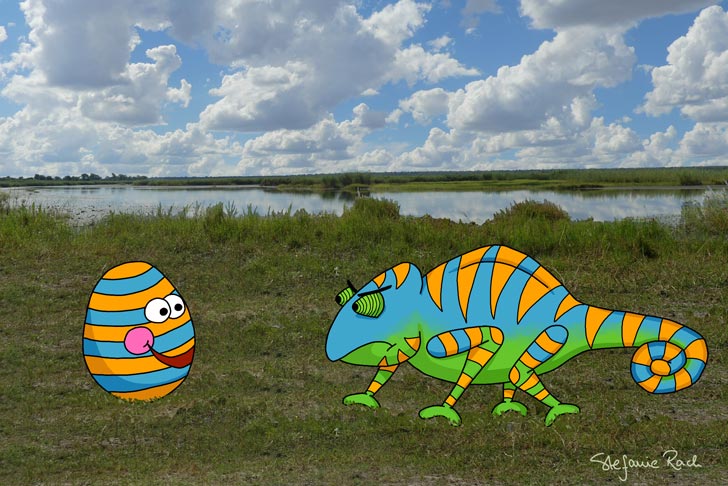If Chameleons Celebrated Easter…
The scent of spring is in the air (at least for everyone in the northern hemisphere), the days are finally a little longer and warmer again and all the spring flowers are delighting us with their colourful blooms. It’s the time of year when we arrange brightly coloured eggs prettily in baskets or hang them in the bushes, and chocolate bunnies smile at us in the shops and the smell of Easter bread wafts through the kitchen.

By Stefanie Rach
But what exactly do we celebrate on Easter? Sure, those who are Christian celebrate the resurrection of Jesus Christ, his death as a sacrifice for humanity and his return to the living.
Let’s take a closer look at the paw print. If the pad has three lobes, the print belongs to someone from the feline family. Lions have the biggest paws, followed by leopards. Every cat, caracal, serval, wildcat, has its very own paw print. When a lion strides majestically, it flicks its paw a little with each step. In loose sand, you can see this in the track, which is slightly smudged on one side. Cheetahs cannot retract their claws and therefore there is a small dot above each toe print where the claw pressed into the ground.
“Easter” is called “Pasen” in Dutch, “Påsk” in Danish and Norwegian, and “Pâques” in French. All these names sound very similar because they derive from the Jewish Passover, which is celebrated at this time of year. It marks the liberation of the Israelites from the slavery of the Egyptians, and thus the beginning of their new life, but with the death of the Egyptians’ firstborn as God’s punishment.
And before Christianity and Judaism? The heaven and fertility goddess Ištar was already worshipped in Mesopotamia more than 3000 years before Christ. As one of the great Sumerian goddesses, she was worshipped for several millennia and is considered the archetype of love and mother goddesses of other later cultures. Ištar descended into the underworld, where she died but was revived and thus returned to her celestial realm (of course there are different versions of this story, but their main plot).
There is less historical evidence of Eastre, the Germanic goddess of spring and fertility. A great festival was held in her honour at the spring equinox.
And the Easter bunny and Easter eggs? Both have symbolised fertility and new life for thousands of years and in many cultures.
So the exact origin of Easter is not known, but possible influences are. And however Easter is celebrated, it is ultimately about overcoming the dark times (and death), about a new beginning, about life and the emergence of new life.
And what does all this have to do with chameleons? Absolutely nothing. Apart from this idea that arose in my head when I was looking at the colourful Easter decorations in Germany, that an equally colourful chameleon would be a great addition. So I had to create a cartoon with a chameleon and an Easter egg. But what would a chameleon do with an Easter egg? Nibble it up after it has found the Easter egg? Hardly. Chameleons mainly feed on insects, which they catch with their tongues. Their tongue is 1.5 to 2 times as long as the chameleon itself (so for us humans, it would be like carrying around a 3 to 4 metre long tongue). Because their tongue is made of an elastic tissue, chameleons keep it folded like an accordion. When they have their next meal in sight, they contract the muscles in their tongue, which is like pulling back the string of a bow. Then the tongue shoots out at an incredible speed: a chameleon tongue accelerates from 0 to 100 kilometres per hour in a hundredth of a second! Ideal conditions for catching insects – but not Easter eggs. Well, maybe my chameleon didn’t find the Easter egg at all, but hid it? Maybe the Easter bunny and the chameleon have adapted to our modern working world and now do job sharing? Well, that would be a rather unfavourable idea. Because chameleons are not the fastest. Since they feed on insects, they move very slowly so as not to accidentally startle their next meal. Likewise, they don’t want to be seen by other predators whose diet includes chameleons. Moving through the bush at an impressive speed of 0.08 kilometres per hour, they act like a leaf in a breeze and so can be easily overlooked. So if they were delivering Easter eggs, we probably wouldn’t get them until Christmas. Or did my chameleon not recognise the Easter egg as such? Maybe it just saw its colourful pattern and immediately thought that another chameleon was trying to establish itself in its territory.
Chameleons are highly territorial. There is a misconception that chameleons change their colour to blend in with their environment. But they don’t need to do this because they are already perfectly matched due to their natural colouring. In fact, chameleons change colour when they are very agitated. This can be the case during mating season, but also when another chameleon has the cheek to enter their territory. Then they puff themselves up, hiss and show with their bright colours that they are an opponent to be taken seriously. Well, and that’s how the idea for my Easter cartoon came about…
By the way, scientists have found out that chameleons already existed more than 100 million years ago, at the time of the dinosaurs. This means that chameleons have witnessed all Easter traditions of humans across all times and cultures.
Happy Easter!
Every problem has a solution, every solution needs support.
The problems we face are urgent, complicated, and resistant to change. Real solutions demand creativity, hard work, and involvement from people like you.

Stay in the know.
Be ready to act.
To keep up to date with our latest news, events, marches,
campaigns and fundraising activities.
